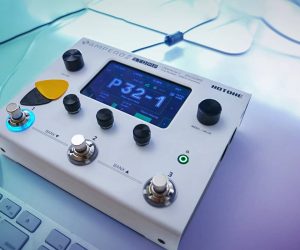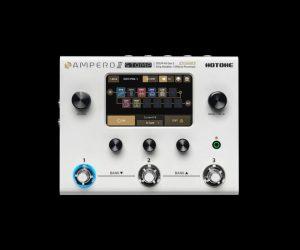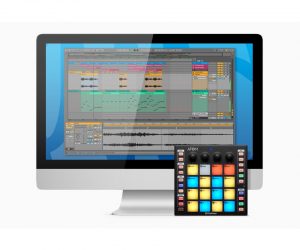
Name Behind the Name: Tom Hidley – Westlake/Eastlake Audio
As one of the world's most influencial acousticians, Tom Hidley has always had plenty to say about the past, present and future of studio design. Andy Stewart interrupts Tom during a pre-retirement fact-finding holiday in Queensland, putting paid any hopes for a quiet life in Australia.
Acoustic design theory is one of the most contentious and confusing topics in audio, and as one of the world’s best known and influential figures in the field throughout the last four decades, Tom Hidley is no stranger to controversy. Beginning his foray into studio design way back in 1965, and as founder of Westlake and Eastlake Audio in the ’70s, Tom has had a huge impact on the history of modern recorded music as we know it – both in terms of our approach to tracking and mixing and the sonic performance of modern recordings. In the ’70s, many of the world’s top producers wouldn’t work in any other space: “If you’re not hiring a Westlake room, I’m not doin’ it!”
Tom Hidley was the inventor of the Westlake ‘turn-key’ studio solution, for which there was even a written guarantee. He succeeded in packaging the unpackageable, rationalising the chaotic minefield of equipment and acoustic treatments into a single purchasable item – something almost unimaginable today. It was Tom who developed the whole concept of studios possessing sonic parity regardless of where on the planet they happened to be, his rooms allowing an engineer to take a master tape from one place to another, lace up the reels and be ready for work – in theory at least. A studio owner who could boast a Westlake Audio facility back then was, without a doubt, at a distinct advantage. And even after three decades – an eternity in terms of technological advancement – Westlake rooms remain scattered throughout the world, some working, others looking a little passé. Regardless, their influence on room design resonates throughout the studio world even now.
Highly successful in his field, Tom has designed more acoustic environments than he cares to remember, several of which are now legendary. He has theorised about acoustic spaces, written about them, designed and constructed them for longer than many of us have been on this earth, and although he now claims to be retired (for the second time in his career), his passion and insightful commentary on acoustics (and anything else you care to discuss) remain undiminished. Primarily responsible for much of what we understand today about frequencies below 60Hz – how they affect rooms, and what materials should be used to manage them – Tom is, in many respects, the king of bottom end. A quietly spoken, considered man, he comes across as a gentle soul, but beneath his mild-mannered exterior and shock of white hair lies a powerhouse of experience and knowledge that is vociferous, and virtually unparalleled in the industry.
I caught up with Tom in Brisbane recently while he was on holiday in Australia, and although I was reluctant to disturb him on his trip, he seemed more than happy for me to do so. During our discussion an interesting fact (among many) arose; that he and his wife intend to move to Australia next year, for, as he puts it; “The sunshine, the clean air and the beautiful fresh produce!” Retirement may be on his mind, but I can’t imagine he’ll be getting much rest once people get wind of his new place of residence…

THE BIRTH OF WESTLAKE AUDIO
Andy Stewart: Years ago when I first started in this business, I never really knew whether Westlake was a concept, a product or a design technique… Can you explain to me what it was and how it got started?
Tom Hidley: The Westlake name originated from the town I was living in at the time, Westlake Village, which is an hour up the Californian coast almost into Ventura County. I started the company in 1969 in my garage. Westlake was principally selling package electronics; that is, everything from the microphone to the final monitor system, amplifiers and consoles.
AS: So you were building entire systems for people, not just Westlake products?
TH: That’s right, we had MCI and 3M tape machines, MCI and API consoles, and all manner of studio equipment, but we also built the studios to house those systems. Westlake was selling the complete electronic package, while at the same time designing and building the studio. By the time the company set up shop on Wilshire Boulevard in Los Angeles, I was designing the studios, our sales department was selling and packaging the gear, and our carpenters were building the rooms. “From design to downbeat” was the Westlake motto of the day.
Later when I left the company, sold it and went to Europe, I started a new company, Eastlake Audio, which was primarily focused on the design, construction and supply of monitors. The reason for the change of focus was that the industry was moving so quickly; I felt that no single person or company could do it all and get it all right. Even keeping up with the technology of the day was difficult. I had to specialise in what I felt I did best – designing acoustic environments.
AS: What made you sell Westlake Audio so soon after it was established?
TH: I had an argument with the other stockholders about expansion soon after we’d successfully completed three new studios in Europe: one for The Moody Blues back in 1973-74; Manor Studios in the countryside near Oxford in the UK for Richard Branson; and Mountain Studios in Montreux, Switzerland for Anita Kerr in ’75. I returned to the US from those ’75 releases – the two rooms were released a week apart – absolutely elated, thinking this was a new hit concept. I went back to my LA office and said, “Guys, we have to expand and open a European office.” But, hands down, everybody was against me. So I said, “All right I’m out of here. You guys own Westlake, this is the financial settlement and I’m gone.” It was just politics. So that was how Westlake and I parted company and why Eastlake came into being in 1975.
AS: For how long were you at the Eastlake helm?
TH: Up until 1980. That’s when I sold it, retired, went to live in Hawaii and lay on the beach. But I got restless doing that because I couldn’t get certain unresolved acoustic questions out of my mind. I was always asking myself, “How could I have made my rooms better? What areas of understanding could be opened up that will take us to the next level?”
The fact is I was never satisfied with anything I did. For a time there through the ’70s my acoustic designs really progressed, and each new studio construction yielded a better product than the one before. It was like peeling back the onion, as more and more design ideas were put into practice, each studio taught us something new. But by around 1978/79 the acoustic development and learning curves seemed to plateau. The designs had reached their peak and I couldn’t squeeze any more out of them. That was about the time I thought, well, I don’t have anything more to contribute so I’d better back off. That’s when I sold Eastlake Audio and retired.
AS: Why had your designs run out of their capacity for improvement?
TH: It was principally the room design. It’s important to remember that back then we were learning as we went – there were no books written on it at the time, so there were inevitably successes and failures – mistakes were part and parcel of the learning curve. There were inherent core flaws in those earlier rooms, and until they were remedied, the room designs weren’t going to improve sonically. In simple terms, the rooms were often misrepresenting what the speakers put out – for a number of interacting reasons – and we couldn’t quite work out why.
AS: So how did you break through the barrier?
TH: One day I was lying on the beach in Hawaii after I retired the first time, and it suddenly occurred to me. I postulated that maybe there was a reflection problem built into the rooms that was constant throughout my designs. Sure enough I was right and ultimately that was the turning point of the design. I left the beach, went back to Switzerland, and into business in ’86, trading under my own name, where I immediately set about putting some of these new design criteria into the structures of my new rooms. And, sure enough, the sonic difference was obvious. The sonic barrier that had existed up through and including any of my rooms up to 1979 was gone.
AS: So what was the barrier?
TH: All the acoustic problems in our rooms that were evident up to and including 1979 were the result of hard surfaces near the monitor wall, and hard surfaces in the ceiling forward of the engineer. There were other major things that were dealt with as well. Wood floors that resonated due to low frequency emission out of the monitor wall was another issue. A wood frame monitor wall system (with three angles to it, in the case of most music control rooms) vibrates whenever a monitor’s low frequency is energised. It occurred to me when I was lying on the beach (it’s a good place to work things out I find!) that the timber-framed monitor wall structure wasn’t completely transferring the speaker energy into the aural part of the room. Some of the energy was going into the structure of the walls and the floor, which meant that the structure, particularly the monitor wall, was subtracting certain frequencies from the monitors, which was obviously affecting the overall room response. So I asked myself, “How can I improve the stability and isolation of the monitor wall?” I figured the answer was mass.
With this in mind, the next room I built [in 1985 while still retired] consisted of a wood-framed monitor wall in-filled with concrete, from the top down through the stud system to the floor. There was also an inner box for each monitor within the wall comprised of four inches of concrete. The monitor was now in a rigid wall system with 1/8-inch airspace allowing normal and requisite cabinet flexing, but encased in concrete. This meant that there was no (or minimal) transfer of low-frequency energy from the box to the wall system because the wall was rigid and stable. It’s the way I’ve done it ever since.
Now suddenly, when you do that, the bass stiffens up in the room because there’s no flop and motion on the monitor wall… You can put the palm of your hand on the wall while the speakers are pumping out 120dB SPL low end into the room and you won’t feel a thing. It’s stable, very stable.
AS: So the concrete wall system and the soffit-mounted speakers are primarily about bottom-end control?
TH: That’s right. The wall and room size establishes the height and angle of the monitors and provides a mounting surface that’s flush with the front of the speaker cabinets. If a monitor is free-standing or hanging in a room, the extreme lows will wrap right around the sides, go to the wall behind, hit that wall, and reflect back into the room, delayed a few milliseconds. When this reflection re-combines with the original signal the phase discrepancy between them loosens the low end emanating from the woofer. I can tell you that at 10Hz (down in the infrasonic range) freestanding systems measured a metre in front, a metre behind, and a metre on the side of the speakers will yield exactly the same pressure from all sides of the cabinet due to the low-end ‘wrap’.
So the soffit mounting serves a two-fold process: to keep the image phase correct and also to stabilise the bottom end and isolate the speakers from the structure. I’ve always argued that flush mounting speakers is a better way to set them up than having them free-standing. It was something that I learned when I worked at JBL in the ’50s. But like anything, there are good and bad ways to soffit-mount speakers.

PROBLEM ROOMS – SOME DO’S & DON’TS
TH: Room design is a semi-repeatable process but there are certain rules that you must abide by, and if you don’t, certain things will happen. We don’t know what all the permutations are yet, but after 40 years we do know what the bulk of them are. Most of the fundamental problems have already been explored and dealt with over the years, but again, I have to say, it’s a semi trial and error thing. It’s also a very subjective field. The reality is people hear differently.
AS: But isn’t there a strange contradiction in that? How do you tread that fine line where, on the one hand, acoustics is entirely subjective because people hear differently, and on the other, you have measuring devices and mathematics to provide substantive ‘proof’?
TH: There are certain things that are related to math in the design of a room, and others that relate to subjectivity, and they can co-exist. There’s also, at this point in time, a set of known situations – of construction, of geometry, of reflections – that influence a design. It’s generally known what a design’s net result will be prior to the construction phase because you’ve done it before and you know what the result was previously – and, all things being equal, the outcome is repeatable. Time has also established a significant list of absolute ‘do-nots’, particularly in control room design…
AS: In simple terms, what are some of these basic rules, given that most people nowadays work primarily at home and probably break several rules of acoustic theory, in many cases without even realising it?
TH: Well, for instance, in the home, virtually everyone endures parallel walls. That’s a mid band and a low-end standing wave problem. Sometimes it’s a high frequency problem, it all depends on the type of room and the angles, the distance from one wall to the other and the finishes. You can get rid of a lot of high-frequency and mid-frequency nastiness between parallel walls just by inserting a simple cotton velour drape down one of the walls, but that doesn’t change the low-end character that a parallel rigid wall system will present to the room. Parallel walls will present a bump and a dip (a standing wave), and the distance between the walls will determine the frequency. Those things are mathematical, there’s nothing abstract about them.
Another rule of thumb is, never use monitors that are ‘too big’ (low frequency-wise) for your room. If you have a monitor system that goes down to 20Hz and you attempt to put it in a room that’s incapable of reproducing that frequency, what will happen? The monitor will attempt to produce 20Hz and the room will say, “Sorry, I can’t deal with that.” The result is like air in a balloon; as you come from both sides and start squeezing, something’s going to pop out between your fingers. If you put a monitor that goes down to 20Hz into a room that only has a 30 or 40Hz capability in wave distance, you’re going to create a huge bump about an octave above the fundamental frequency that the monitor’s producing. And you’ll never get rid of that bump, because you’re introducing something into that room that shouldn’t be introduced (Wavelength Physics). If you’re going to build a small control room, match the monitor’s low frequency capability to the size of the room! (half the wavelength of a room’s longest dimension should equal the maximum low frequency from the room’s monitor.)
You can size your monitor downward in frequency as long as the room possesses the dimensions to carry it.
...never use monitors that are ‘too big’ for your room... like air in a balloon... as you start squeezing, something’s going to pop out between your fingers.

THE SOUND OF SURROUND
AS: What about the whole surround sound dilemma? If a stereo room has a typical ‘send and receive’ design (forward-firing monitors with the engineering facing towards them), doesn’t placing surround monitoring in such a room basically throw the whole design principle out the window?
TH: Sure it does.
AS: What’s the difference then between the design of a 5.1 room and a stereo room in your opinion? Are they radically different?
TH: This is a really controversial subject. Let me say up front that I am a purist. I have a music background, I don’t like things that aren’t naturally musical and I reject things that introduce colouration – electronic or acoustic – into a control room’s musical product. That doesn’t mean I don’t build and design 5.1 rooms, I do. However, I believe the way 5.1 rooms are currently expected to be built is incorrect from a sonic perspective. Now, that puts me at odds with the establishment and the expected norms of today, but I don’t care, I have those feelings, I’m honest with you and I’m up front about them. I’ll also go one step further and say that, in my opinion, a well-designed 5.1 room will never attain the sonic purity that a stereo room is capable of. Now a stereo pair with a centre monitor forming a three-monitor front is okay. But you don’t have a phantom centre then, you have a locked centre.
AS: By a locked centre, I presume you mean an actual centre? A real source, not just the illusion of a centre speaker…
TH: Correct… stereo has a phantom centre. A ‘locked centre’ is the centre-stage vocalist with the band behind left and right. That’s fine. Reproducing that with three monitors? Great. However, in my opinion, you should never build those three monitors in a wrap monitor configuration monitor wall, they should be built on a straight horizontal wall – for the purest sonic effect. With a three-angled monitor wall you will never get the locked centre to musically fully phase-gel when panning from centre to left or right. The trajectory of sound into the room from the monitor wall is what it’s all about for acoustic phase coherency. It’s one of the mandatory things that you have to have if you want sonic neutrality via absolute phase trajectory symmetry. And that doesn’t exist in the typical 5.1 setup or curved front monitor wall.
AS: Obviously most people place the front three speakers of a surround system in an arc in an attempt to time-align the centre speaker. Is this a mistake in your opinion?
TH: It is. The standard surround configuration is a circle, and you put all five monitors around its perimeter. I’m doing this right now in Hong Kong in one of the rooms that we’re building. But absolute phase-linearity between left and centre, or right and centre, is unachievable in this arrangement. The centre monitor, which comes in at a different trajectory and a different angle to the mid and high frequencies from the left and right instantly creates phase distortion, you can hear it. Sibilance worsens, brass instruments become edgy – things become kind of electronic sounding, a little pitched. The open musical natural character of the stereo pair is downgraded by the centre speaker when centre material is panned to partial left or right if the centre is flanked by left and right monitors that are angled in towards the listener.
So I don’t abide by the wrap monitor front wall. Although I’m the one that started that damn thing in 1969 at Record Plant Third Street, Los Angeles! I did it because the monitors we were using there had very bad horizontal dispersion. When you ran them straight into the room you couldn’t hear the top end unless you slid up and down the console. So, to overcome that, we angled them in. It seemed like a smart idea at the time… unfortunately that has stuck in the industry ever since. People do it everywhere now – sorry!
AS: How then do you embrace the idea of designing a surround room if you find 5.1 systems so unpalatable?
TH: I don’t like it. I think it’s wrong… but clients demand it. Why? Because the industry has put it forward as a standard and they require it to be able to work compatibly with the industry’s accepted norms.
It is my opinion that surround sound was introduced and promoted to emphasise ‘special effects’ in the film industry and not as a musical format. But as with so many things in life, a good start can, and frequently is, drawn away from its original good intention and downgraded in future applications not originally envisaged or intended. To me, surround sound for music is just a gimmick.
AS: In principle, did you feel the same way about quadraphonic rooms back in the ’70s? You seemed to embrace that concept at the time…
TH: Yes, we built quadraphonic rooms at Westlake. We even had a quad mix demo room with an API console at its heart. We used it to demonstrate electronic equipment.
AS: As a design principle then, is 5.1 a dead end (no pun intended) in your opinion?
TH: A 5.1 room with surround material will never give you the sonic purity you can get from a two-channel room. As I said earlier, I’m happy to accept a three-channel front (straight horizontal wall), but if there are to be surrounds they should never, in my opinion, be used for handling music product, only effects, reverberant reflections or applause as originally intended by the film industry. I don’t fight that at all, because that’s natural. What I fight is the placement of music all the way around you in defiance of a visual cue. It’s a gimmick and I find it very offensive. But do I design it and build 5.1 rooms? Yes. If I want to work, that’s what I’ve got to do. Do I like it? No. Is it right? In my opinion, no.
AS: So when you’re building these rooms do you try and explain the pitfalls to clients or convince them not to go surround?
TH: If the client is capable of understanding it, I’ll sit and talk with them and explain the situation. But in the end, they’re working in a market that demands this format. I can’t advise them not to embrace the format in the face of that demand. Surround sound has become far too engrained to ignore. Will it come and go like quad? Probably not.
RETIREMENT?
AS: I heard a rumour that you were contemplating moving here.
TH: That’s true. My wife and I will be moving to Australia next year. I have a four-year retirement visa. I’m really looking forward to it.
AS: It will be interesting to see how you feel about Australia when you come back permanently. You might find a queue developing to engage your services.
TH: I’ll love it. The people, the food, the weather… you name it. Those are the main fundamental ingredients of life.
















RESPONSES